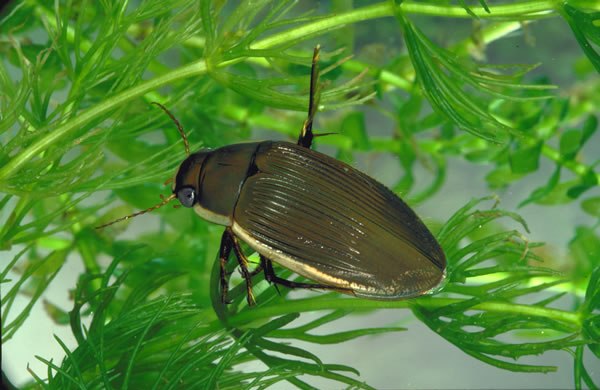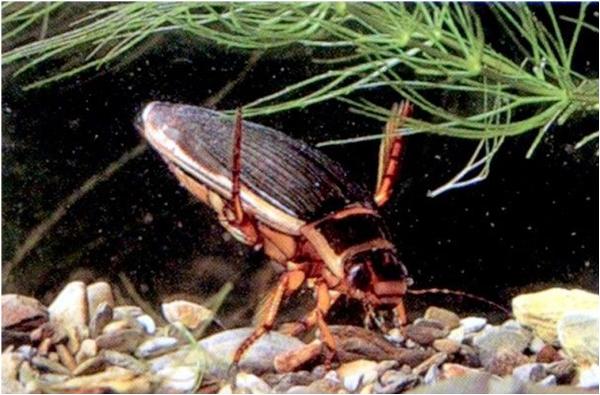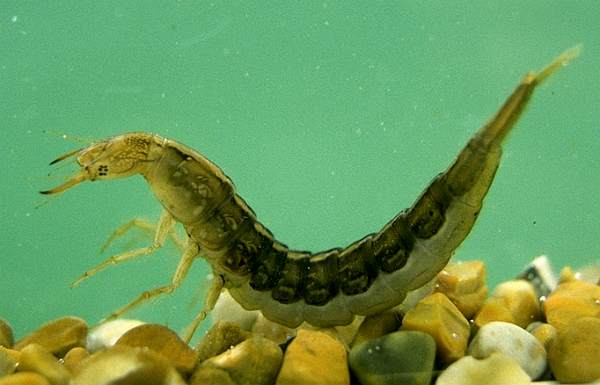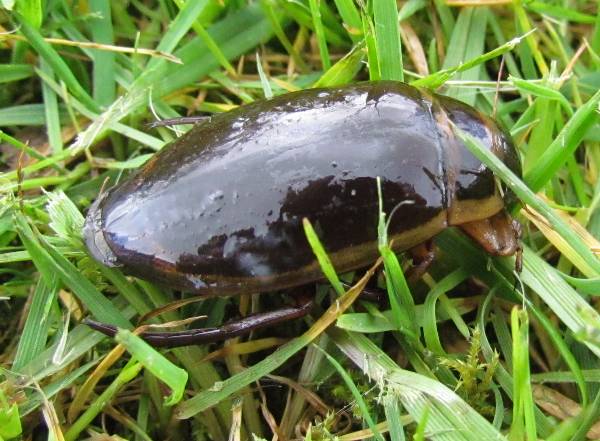Trees Birds Mammals Fish Amphibians Reptiles
Wild Algarve
Bookshop
Dytiscus marginalis - Great Diving Beetle
Phylum: Arthropoda - Class: Insecta - Order: Coleoptera - Family: Lucanidae

Female Great Diving Beetle
At some 3cm long, this is one of the largest beetles found in Britain and Ireland. The Great Diving Beetle inhabits still or very slow-flowing freshwater, usually where there is plenty of submerged vegetation among which it can hunt its prey.

These beetles have dark-brown wing cases (elytra) with an olive tinge and a brownish-yellow border. The females' wing cases are ribbed, while those of the males are smooth. Both males and females have dark, olive-brown, almond-shaped bodies, about three centimetres long, and thoraces bordered by dull yellow. In the UK and Ireland, the wing cases of the female are ribbed whilst those of the male are smooth. (In some parts of mainland Europe, females with smooth elytra are also recorded.)

Larva of Great Diving Beetle
Description
The fearsome appearance of the adult beetle is more than skin deep: they can give a finger a very painful nip! The larvae are typically 5cm long, and despite having soft bodies these larvae are capable of tackling large prey such as young newts, froglets and even small fishes, so human finger skin presents no obstacle to them!
Life cycle
Great Diving Beetles mate and the females lay their eggs in early spring, inserting them singly into submerged aquatic plant stems. The eggs take typically 18 days to incubate. The young larvae grow rapidly, and by late summer they are ready to pupate; before doing so they leave the water and burrow in wet marginal soil. The young adult beetles emerge from their pupae (they 'eclode') typically in mid autumn, but they remain buried in the wet soil through the cold winter months, returning to the water as the days lengthen and get warmer.

Above: out of water, a male Dytiscus marginalis with its smooth elytra
Adult Great Diving Beetles are strong fliers, but for the most part this activity is nocturnal. Newly created garden ponds are often populated in this way during the first year after construction.
References
Harde K.W. & Severa F. (1984) Field Guide in Colour to Beetles. Littlehampton Book Services.
Acknowledgements
This page includes pictures kindly contributed by the Countryside Council for Wales.
Excited by rivers and streams? So are we, and we're pretty sure you would find the Winding River Mystery trilogy of action-packed thrillers gripping reading too. Dead Drift, Dead Cert, and Dead End are Pat O'Reilly's latest river-based novels, and now they are available in ebook format. Full details on our website here...
Buy each volume in ebook format for only £2.47 on Amazon... Paperbacks also available on Amazon at £6.95 each. All proceeds go towards keeping the First Nature website online.
Please Help Us: If you have found this information interesting and useful, please consider helping to keep First Nature online by making a small donation towards the web hosting and internet costs.
Any donations over and above the essential running costs will help support the conservation work of Plantlife, the Rivers Trust and charitable botanic gardens - as do author royalties and publisher proceeds from books by Pat and Sue.